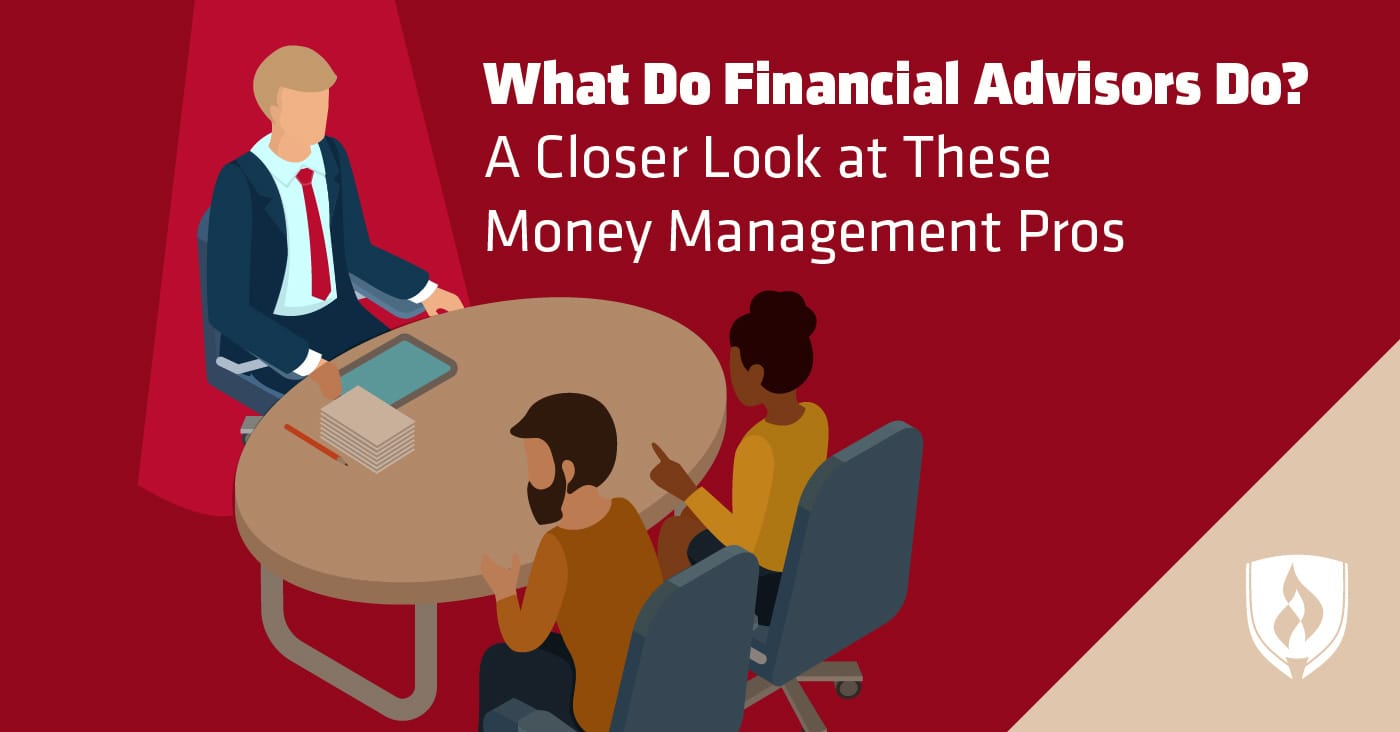What Do Financial Advisors Do? A Closer Look at these Money Management Pros
By Anjali Stenquist on 03/30/2020

You’ve always had a mind for money. Growing up, you were the kid budgeting your allowance in order to afford a big-ticket item. Nowadays you keep a close eye on your budget and love the idea of planning out your financial future. So it’s only natural if the role of a financial advisor has caught your interest.
While the title seems pretty self-explanatory—they advise people on their financial decisions—there’s still a lot about this job that you don’t know much about. Is it still a viable career option? What’s enjoyable about the job? What’s not-so-great about it? Would I like it?
If you are interested in learning more about a career that can make a profoundly positive impact on people’s lives, you’re in the right place. We rounded up important career information and asked experienced financial advisors to weigh in on their experiences in this career.
What is a financial advisor and what do they do?
Put simply, a financial advisor is a professional who develops financial strategies for their clients in order for them to meet financial goals. They work closely with clients to understand their financial situations and future plans and then use that information to lay out potential plans. They field client questions, address concerns and help with the overall management of their financial accounts. The Bureau of Labor Statistics states typical duties of personal financial advisors include:1
- Meeting with clients in person to discuss their financial goals
- Explaining the types of financial services they provide
- Educate clients and answer questions about investment options and potential risks
- Recommend or select investments for clients
- Help clients plan for specific circumstances like retirement
- Monitor client accounts and determine if changes are needed to improve performance
Financial advisors are able to deeply understand their client’s needs and where they might be coming to a false conclusion or assumption based on incomplete information or even personal biases. Being a financial advisor is a mix of financial detective work, sales, counseling and a whole lot of problem solving.
What are some pros and cons about being a financial advisor?
Now that you have a better understanding of what’s typically on the plate of a financial advisor, let’s dig into both the good and bad that comes with this work. Let’s start with the challenges.
“By far the biggest challenge is overcoming the public’s general perception that financial advisors are only out to sell them products for a commission to make money for themselves,” says Matt Elliott, Certified Financial Planner and founder of Pulse Financial Accounting. “This isn’t entirely unwarranted—it’s rare I talk to a client over the age of 40 that hasn’t already had a negative experience with a commission-based financial salesperson.”
Another challenge for financial advisors is finding ways to provide value beyond what do-it-yourselfers armed with personal finance apps receive. The economic crisis in 2008 left many young people distrustful of the financial sector. For some, it might seem safer to take advice on how to plan financial growth from a smartphone. Increasingly accessible and well-designed technology, combined with a feeling of financial advisors being out of touch with young people’s needs and aspirations, has made some hesitant to work with financial advisors.
“This means as financial advisors, you’ll need to add value beyond what technology can do cheaper and more efficiently than you can,” says Elliot. “The good news is there will still be a ton of work to do that a computer will never be able to do. Most of the mistakes people make with their investments are based on their own emotions.”
Another challenge facing the financial advisor industry is a shift in demographics.
“The average age of a financial planner is 55 or older,” says Gregory J. Kurinec, CFP. “There is a desperate need for new advisors to fill these rolls that will be vacated by retiring advisors. With that will come a change of approach. Advisors need to learn to be comprehensive in their approach, covering all aspects of an individual’s financial wellbeing.”
And for the good? Our advisors all enjoy the fact that their work assists people as they navigate their financial goals—and also enjoy the challenge of devising plans to fit their specific needs.
“I truly enjoy building financial plans for people,” says Elliot. “I look at it as a puzzle—people come to me with their current set of circumstances, an idea for what they’d like to build, and a set of restraints. For example: ‘Currently I have $20,000 in student loans, I’m spending what I earn, and I am not willing to work past the age of 60.’ Getting all the pieces together for their financial puzzle and making them fit is enjoyable to me.”
The nature of this work also means there’s the opportunity to build long-term relationships with clients—and these deep connections can make a successful financial plan all the more rewarding to see.
“What is incredibly satisfying though is working with clients long term to help them carry out their plan and be successful with it,” Elliot says.
Where do financial advisors work?
The physical work environment of a financial advisor probably won’t come as a surprise—they typically work in an office environment. That said, many will spend a fair amount of time attending networking events or presenting at financial seminars in an effort to grow their overall client base.
A large majority of financial advisors will work for financial services companies, though there are a significant number of advisors who strike out on their own as independent providers. In fact, 25 percent of personal financial advisors are self-employed, according to the BLS.1
What is a financial advisor’s job outlook?
Financial advisors are sometimes compensated for their advisory services with an hourly fee while others charge a flat rate for a financial plan or an annual portfolio review. A good number of financial advisors’ income may be at least partially commission-based. Due to different fee structures, the salary for financial advisors can vary significantly.
Demand for these professionals appears steady—employment of personal financial advisors is projected by the BLS to grow by 7 percent from 2018-2028.1 So what’s behind that steady projection? The BLS notes that as the aging and large Baby Boomer generation approaches retirement, demand for financial planning services should increase.
What skills do financial advisors need?
Financial advisors need a combination of technical knowledge, software fluency, and interpersonal skills. A great deal of financial advising involves building a trusting, professional, and productive relationship with clients.
We analyzed 59,048 financial advisor job postings between January 1, 2019 and December 31, 2019, for the most in-demand skills for financial advisors.
Top technical skills:2
- Wealth management
- Customer service
- Sales
- Securities
- Client prospecting
- Investment strategy
- Business development
- Retirement planning
- Client base retention
- Budgeting
Top transferable skills:3
- Communication
- Planning
- Relationship building
- Collaboration
- Computer literacy
- Microsoft office
- Organization
- Attention to detail
- Mentoring
- Multi-tasking
How do you become a financial advisor?
Financial advisors are able to help their clients because of a vast suppository of financial knowledge. In our analysis of 46,632 financial advisor job posts, we found that 75 percent of employers are seeking a candidate with a bachelor’s degree.2
Beyond a degree, prospective financial advisors may see a benefit in pursuing professional certifications. Some top certifications and credentials for financial advisors include:
- Series 7: A series 7 license allows an individual to sell securities in the United States. To receive a Series 7 license an individual must first pass the Securities Industry Essentials exam (SIE), then they may take the General Securities Registered Representative Exam (GSRE). The GSRE covers topics like financial industry regulations, client communications, the types of securities and their risks.
- Certified Financial Planner (CFP): To be a CFP an individual must have at least a bachelor’s degree, pass the CFP certification examination, demonstrate experience in the field of financial planning, and adhere to the CFP Board Code of Ethics and Professional Responsibility and the Financial Planning Practice Standards.
- Series 66: A Series 66 Certification allows an individual to act as a securities agent by selling stocks, bonds and investments. To receive the certification a person must pass the Series 66 exam covering topics such as regulations, client relations, investment vehicles and economic factors. To receive the Series 66 certificate a person must also pass the GSRE exam necessary for a Series 7 certificate.
Interested in becoming a financial advisor?
There is a significant need for younger workers entering into the field of financial advising with a broader perspective on the American dream. If you are interested in helping people overcome their obstacles and build a financially sound life for themselves and their children, consider a career as a financial advisor. Think you’d be a good fit for this role? Check out our article, “9 Signs You Have What It Takes to Major in Finance.” Also check out, "55 Finance Terms You Should Know Before Investing".
1Bureau of Labor Statistics, U.S. Department of Labor, Occupational Outlook Handbook, [accessed February, 2020] www.bls.gov/ooh/. Employment conditions in your area may vary.
2Burning-Glass.com (analysis of 59,048 financial advisor job postings, Jan. 01, 2019 – Dec. 31, 2019).
3Burning-Glass.com (analysis of 46,632 financial advisor job postings, Jan. 01, 2019 – Dec. 31, 2019).




